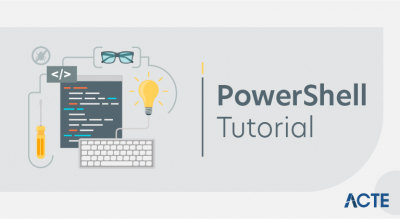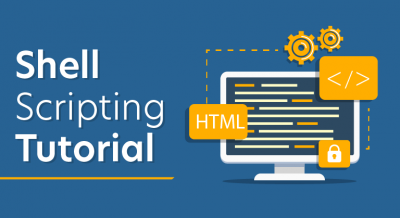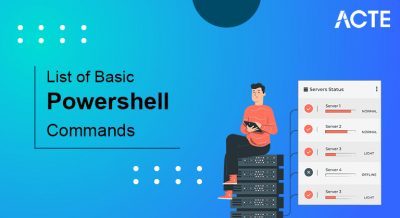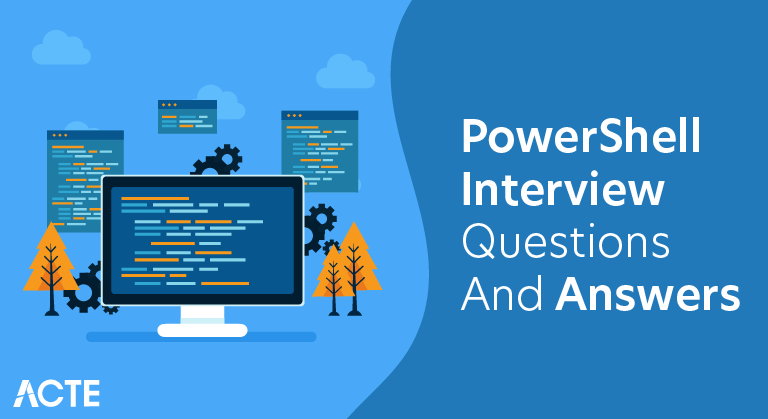
PowerShell is a task automation framework and scripting language developed by Microsoft. It uses cmdlets for specific tasks, follows a Verb-Noun naming convention, and employs a pipeline for command chaining. PowerShell is object-oriented, integrates with .NET, supports remoting, and includes modules for extended functionality. It serves as both an interactive shell and a scripting language, with features like Desired State Configuration (DSC) for system management.
1. What is Microsoft PowerShell?
Ans:
Microsoft PowerShell is a scripting language and task automation framework intended for use in Windows-based system administration. With its object-oriented pipeline, scripting language, and command-line shell, users can automate processes, handle configurations, and run commands from a distance. PowerShell is a cross-platform program; PowerShell Core is the Linux and macOS version.
2. Define the key features of PowerShell?
Ans:
Object-oriented pipelines, scripting languages, remote management capabilities, integration with the.NET Framework, extensibility via custom cmdlets, and cross-platform compatibility with PowerShell Core are some of PowerShell’s key features.
3. What makes up the variables in PowerShell?
Ans:
Naming: Variables in PowerShell start with the “$” symbol followed by the name, e.g., $myVariable.
Data Types: Variables in PowerShell are loosely typed, accommodating various data types such as strings, integers, arrays, and objects.
Assignment: Values are assigned to variables using the “=” operator, like $myVariable = “Hello, World!”.
4. In PowerShell, what according to you is the implication of brackets?
Ans:
- Square brackets [] declare arrays.
- Curly braces {} define script blocks and hashtables.
- Parentheses () create subexpressions.
- Brackets are used for array indexing and accessing object properties.
5. What is your understanding of cmdlet?
Ans:
Cmdlet in PowerShell: Lightweight command following Verb-Noun naming convention, designed for specific tasks. Operates on objects, facilitates consistent and efficient automation.
6. Are you aware of PowerShell Loop?
Ans:
PowerShell loops, such as for, foreach, while, and do-while, enable automated repetition in scripts. They’re instrumental for iterating over collections or executing code based on specific conditions. This flexibility enhances the efficiency of PowerShell scripts, streamlining the automation of various tasks.
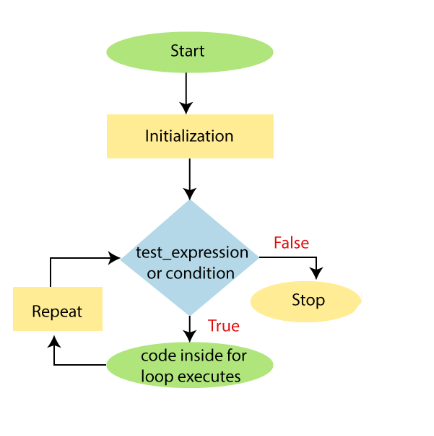
7. Can PowerShell scripts be created for the deployment of SharePoint components?
Ans:
PowerShell scripts are commonly used to deploy SharePoint components by automating tasks such as solution deployment, site provisioning, user management, service application configuration, and monitoring. The scripts leverage SharePoint cmdlets for these tasks, streamlining the deployment and management processes.
8. What is your idea about comparison operators in PowerShell?
Ans:
PowerShell comparison operators, like -eq (equal), -ne (not equal), -gt (greater than), -lt (less than), -ge (greater than or equal to), -le (less than or equal to), -like, -notlike, -contains, and -notcontains, are crucial for evaluating conditions, making decisions, and filtering data in scripts. They facilitate comparisons between values and help control script flow.
9. What is the use of the PowerShell pipeline?
Ans:
The PowerShell pipeline allows seamless chaining of commands, enabling the output of one command to serve as input for another. It simplifies code, promotes reusability, enhances readability, improves efficiency, and facilitates filtering and combining of data, making complex operations more straightforward.
10. What do you understand by get-command in PowerShell?
Ans:
In PowerShell, Get-Command is used to discover and retrieve details about available commands. It can provide information about specific commands, list all commands, or find commands within a module. Additionally, PowerShell offers functionalities like mapping network drives with New-PSDrive and accessing files on the mapped drives. Commands like Remove-PSDrive can be used to disconnect and remove mapped drives when needed.
11. Could you describe the PowerShell mapping of the network drive?
Ans:
- Choose a drive letter and network path.
- Optionally, create a credential for authentication.
- Use New-PSDrive with parameters for the letter, provider, path, and credentials (if needed).
- Access the mapped drive using the assigned letter (Z:).
12. Since you mentioned scripting, define what Scripting in PowerShell is?
Ans:
Scripting Language: PowerShell provides a scripting language with features such as variables, loops, conditionals, functions, and error handling. The language is specifically designed for managing Windows-based systems.
Cmdlets and Functions: PowerShell scripts often utilize cmdlets (short for command-lets), which are lightweight commands focused on specific tasks. Additionally, custom functions can be defined to encapsulate reusable code.
13. Can you explain the uses of PowerShell Array?
Ans:
PowerShell arrays are fundamental for storing and managing collections of data. They excel at tasks like iterating through elements, enabling easy access via index, and dynamically modifying content by adding or removing items. Arrays support filtering and selecting data based on specific criteria, facilitating the extraction of relevant information. Sorting and reversing operations help organize elements for presentation or analysis.
14. Define what commands to use in order to get child folders into a specified folder?
Ans:
To obtain child folders within a specified directory using PowerShell, set the $parentFolder variable to the path of the desired parent folder. Utilize the Get-ChildItem cmdlet with the -Directory parameter to specifically fetch directories. The retrieved child folders are stored in the $childFolders variable. Finally, you can iterate through or manipulate the list of child folders as needed for your script or automation. Adjust the path in $parentFolder to target the directory of interest.
15. Could you describe how to convert an object to HTML?
Ans:
ConvertTo-Html Cmdlet: Use ConvertTo-Html in PowerShell to transform objects into HTML format.
Full HTML Document: For a complete HTML document, pipe the output of ConvertTo-Html to Out-File to save it as an HTML file.
HTML Fragments: To generate HTML fragments, add the -Fragment parameter to ConvertTo-Html and pipe the result to Out-String.
16. Can you define how you will assign a different name to a variable?
Ans:
Changes Affect Both: Modifying either variable impacts the other, as they share the same data.
No Data Duplication: This assignment doesn’t duplicate the data; it creates an additional reference.
Establish New Variable Name: The process results in having a different variable name ($newVariable) for the same underlying data.
17. Are you aware of the $input variable? What are its functions?
Ans:
The $input variable in PowerShell represents input received from the pipeline. It allows scripts or functions to process and iterate over objects passed through the pipeline. This variable simplifies handling input data, making it a convenient tool for pipeline-based operations.
18. How do you suppose one will discover that PowerShell’s SQL services are located on a single server?
Ans:
- Use Get-Service -Name “MSSQL*” to check for SQL Server services on the server.
- Utilize SQL Server Management Objects (SMO) for detailed information about the server.
- Query the registry for installed SQL Server instances using Get-ItemProperty. These methods provide insights into the presence and configuration of SQL Server services on the server.
19. What is PowerShell?
Ans:
PowerShell is a task automation framework and scripting language developed by Microsoft. It consists of a command-line shell and a scripting language designed for system administration. PowerShell is built on the .NET Framework and supports the automation of administrative tasks through cmdlets (pronounced command-lets), which are specialized .NET classes.
20. How does PowerShell differ from the Command Prompt?
Ans:
PowerShell vs. Command Prompt: While both are command-line interfaces in Windows, PowerShell is more powerful and versatile. PowerShell uses a scripting language, whereas the Command Prompt relies on commands and batch scripts. PowerShell supports object-based pipeline processing, allowing the output of one command to become the input of another, and it has access to the full range of .NET Framework libraries, making it more extensible than the Command Prompt.
21. Explain the concept of cmdlets in PowerShell.
Ans:
Cmdlets in PowerShell: Cmdlets in PowerShell are small, focused commands that perform specific tasks. They follow a Verb-Noun naming convention, such as Get-Process or Set-ExecutionPolicy. Cmdlets are the building blocks of PowerShell scripts and can be combined in a pipeline to perform complex operations. They encapsulate functionality in a modular way, promoting reusability and consistency.
22. What is the significance of the $ symbol in PowerShell?
Ans:
$ Symbol in PowerShell: In PowerShell, the $ symbol is used to denote variables. Variables store data that can be used and manipulated in scripts. For example, $variableName = “Hello, World!” assigns the string “Hello, World!” to the variable $variableName. This variable can then be referenced or modified throughout the script.
23. Enumerate a few frequently used PowerShell cmdlets.
Ans:
Typical PowerShell Commandlets.
Get-Process: Returns details about a process.
Get-Service: Retrieves a computer’s service status.
Get-EventLog: This command pulls events out of the event log.
24. How can one obtain assistance with a PowerShell cmdlet?
Ans:
Getting Help in PowerShell: To learn more about cmdlets, functions, workflows, aliases, providers, and scripts in PowerShell, use the Get-Help cmdlet. For instance, Get-Help Get-Process offers information on the syntax, parameters, and examples of the Get-Process cmdlet.
25. Distinguish between the Get-Help and Get-Command cmdlets.
Ans:
| Feature | Get-Help | Get-Command | |
| Purpose |
Retrieve documentation for commands |
Retrieve information about commands | |
| Output | Detailed information about the command, including syntax, parameters, examples, and explanations | Information about the command itself, such as its name, module, command type, and definition. | |
| Usage | Get-Help |
Get-Command |
26. What is the Select-Object cmdlet used for?
Ans:
To choose particular properties from the objects that a cmdlet or expression returns, use the Select-Object cmdlet. By selecting only the pertinent data, it assists in filtering and formatting the output. Get-Process | Select-Object Name, CPU, for instance, would only show the process names and CPU utilization.
27. In PowerShell, how do you declare a variable?
Ans:
PowerShell Variable Declaration: The $ symbol is used in PowerShell variable declarations. A variable called $myVariable is declared and given the value “Hello, PowerShell!” in the example $myVariable = “Hello, PowerShell!” Because PowerShell variables are loosely typed, they can contain a variety of data types, including objects, strings, and integers.
- $myVariable = “Hello, PowerShell!”
28. Which data types are frequently used in PowerShell?
Ans:
Integers ([int]), floating-point numbers ([double]), strings ([string]), arrays ([array]), hash tables ([hashtable]), booleans ([bool]), and more data types are supported by PowerShell. Furthermore, PowerShell is adaptable for managing various data structures since it makes use of object-based types, which permit manipulation of.NET objects.
29. Explain the difference between a value type and a reference type in PowerShell.
Ans:
In PowerShell, value types store their actual values, while reference types store references or pointers to the memory location where the data is stored. Value types include simple data types like integers and booleans, whereas reference types include objects and complex data structures like arrays and hash tables. Changes to value types do not affect other variables, whereas changes to reference types may impact other variables pointing to the same object.
30. What is the file extension for PowerShell scripts?
Ans:
PowerShell scripts typically use the .ps1 file extension. This extension signifies that the file contains PowerShell commands and can be executed as a script.
31. How do you comment on a line in a PowerShell script?
Ans:
To add comments in a PowerShell script, you use the # symbol. Anything following # on a line is treated as a comment and is ignored during script execution. Comments are useful for providing explanations, making the code more readable, and documenting the script’s functionality.
32. Explain the purpose of the Write-Host cmdlet.
Ans:
The Write-Host cmdlet is used to display information directly to the console. Unlike Write-Output, which sends data down the pipeline, Write-Host is specifically designed for generating console output. It’s commonly used for displaying user prompts, status messages, or other information that should be visible to the user running the script.
33. How can you run a PowerShell script?
Ans:
Open PowerShell: Search for “PowerShell” in the Start menu or use the Windows PowerShell shortcut.
Set Execution Policy (if needed): Open PowerShell as an administrator.
Run: Set-ExecutionPolicy RemoteSigned to allow locally created scripts.
34. List some looping constructs in PowerShell.
Ans:
PowerShell includes various looping constructs, such as foreach, for, while, and do-while. These constructs enable you to iterate through collections, perform repetitive tasks, and control the flow of your script based on certain conditions.
35. Explain the usage of the foreach loop in PowerShell.
Ans:
Iteration: foreach is used in PowerShell to iterate over elements in a collection.
Syntax: It follows the structure foreach ($item in $collection) { … }.
Variable: $item represents the current element during each iteration.
36. In PowerShell, how do you write an if-else statement?
Ans:
Condition Evaluation:
- The if statement begins with the keyword if, followed by a condition in parentheses.
- The condition is evaluated as either true or false.
Code Blocks:
- If the condition is true, the code block within the curly braces {} following the if keyword is executed.
- If the condition is false, the code block within the curly braces {}.
37. What is the PowerShell switch statement used for?
Ans:
Multiple conditional tests in PowerShell are performed using the switch statement. It offers a clear and understandable method for handling various scenarios according to the value of an expression or variable. When handling several conditions, a switch statement may be more effective than a sequence of if-else statements.
38. In PowerShell, how do you define a function?
Ans:
The “function” keyword, the function name, and two curly braces are how you define a function in PowerShell. You write the code that defines the function’s functionality inside of the braces. After the function name, parameters can be declared in parenthesis, and the “return” keyword is frequently used to control the output.
39. Explain the difference between a function and a cmdlet.
Ans:
The main difference between a function and a cmdlet in PowerShell lies in their origin and usage. A function is a user-defined block of code written in PowerShell scripting language, created to perform a specific task. On the other hand, a cmdlet (command-let) is a pre-built, compiled command that comes with PowerShell. Cmdlets are generally more specialized and are designed to perform specific administrative tasks.
40. How can you pass parameters to a function in PowerShell?
Ans:
Parameters can be passed to a function in PowerShell by declaring them within parentheses after the function name. Inside the function, you can then reference these parameters using the “$” symbol followed by the parameter name. When calling the function, you provide values for these parameters in the order they are declared.
41. What is the significance of the pipeline in PowerShell?
Ans:
The pipeline in PowerShell is a powerful feature that allows the output of one cmdlet or function to be passed as input to another. This chaining of commands enables the creation of complex, yet readable, one-liner scripts. The pipeline enhances the efficiency and flexibility of PowerShell scripts by allowing the seamless flow of data between different cmdlets and functions.
42. Explain the concept of object-oriented pipelines in PowerShell.
Ans:
Object-oriented pipelines in PowerShell treat data as objects rather than simple text. This means that the output of one command is treated as an object with properties and methods that can be manipulated by subsequent commands. This object-oriented approach makes it easier to work with structured data, facilitating more sophisticated data processing and manipulation.
43. How can you sort objects in PowerShell?
Ans:
Sorting objects in PowerShell is accomplished using the Sort-Object cmdlet. By piping the output of a command or function to Sort-Object, you can specify the property by which to sort the objects. For example, to sort a list of objects by their “Name” property, you would use Sort-Object -Property Name.
44. What is the purpose of the Try, Catch, Finally blocks in PowerShell?
Ans:
- The Try, Catch, Finally blocks in PowerShell are used for error handling.
- The “Try” block contains the code that might throw an exception. If an exception occurs, the “Catch” block is executed, allowing you to handle the exception by specifying actions to be taken.
- The “Finally” block, if present, is executed regardless of whether an exception occurred or not. It is used for cleanup activities.
45. How do you generate and handle exceptions in PowerShell?
Ans:
In PowerShell, exceptions can be generated using the “throw” keyword. To handle exceptions, you use the Try, Catch, and Finally blocks. The “Try” block contains the code that might generate an exception. The “Catch” block specifies how to handle the exception, and the “Finally” block, if used, ensures that certain code is executed whether an exception occurred or not.
46. What does a module mean in PowerShell?
Ans:
A self-contained, reusable script comprising a collection of associated variables, cmdlets, and functions is called a PowerShell module. Code can be easily shared and reused across various scripts and sessions by using modules to package and organize it. They encourage code organization and reusability and keep PowerShell scripting modular and scalable.
47. How does one import a module into PowerShell?
Ans:
The Import-Module cmdlet in PowerShell can be used to import a module. Use the command Import-Module ActiveDirectory, for instance, to import the Active Directory module. This makes it possible to use the cmdlets and functions of the module in the current session.
48. Explain the purpose of the Export-ModuleMember cmdlet.
Ans:
The Export-ModuleMember cmdlet in PowerShell is used to explicitly define which functions, aliases, and variables from a module should be exported and made available to the outside world. It helps control what becomes part of the module’s public interface, allowing module authors to expose only the necessary elements while keeping the internal implementation details hidden.
49. How can you run PowerShell commands on a remote computer?
Ans:
PowerShell provides the Invoke-Command cmdlet for running commands on remote computers. You can use the -ComputerName parameter to specify the target machine and the -ScriptBlock parameter to provide the PowerShell script or command to be executed remotely.
50. What is the significance of the Invoke-Command cmdlet?
Ans:
The Invoke-Command cmdlet is significant for managing remote computers in PowerShell. It enables the execution of PowerShell commands or scripts on one or more remote computers, allowing administrators to perform tasks, gather information, or make changes across a network without physically being on each machine.
51. How do you install the Active Directory module in PowerShell?
Ans:
The Active Directory module is part of the Remote Server Administration Tools (RSAT). To install it, you can use the PowerShell command Install-WindowsFeature RSAT-AD-PowerShell. This installs the necessary components for managing Active Directory with PowerShell.
52. Provide a list of popular PowerShell Active Directory cmdlets.
Ans:
- Obtain user accounts from Active Directory using the Get-ADUser command.
- New-ADUser: Establishes a fresh user profile.
- Set-ADUser: Adjusts an existing user account’s properties.
- Delete a user account with Remove-ADUser.
- Get-ADGroup: Obtains objects for a group.
- New-ADGroup: Forms an entirely new group.
53. How can PowerShell be used to retrieve user information from Active Directory?
Ans:
To obtain details about a user in Active Directory, use the PowerShell Get-ADUser cmdlet. Take Get-ADUser -Identity username, for instance. This command returns details such as username, display name, distinguished name, and other attributes of the specified user.
54. What does Windows Management Instrumentation, or WMI, stand for?
Ans:
Microsoft’s WMI set of specifications offers a standardized method for gathering and managing data about computer systems. It gives administrators access to and control over Windows-based operating systems’ resources, settings, and data.
55. How can PowerShell be used to query WMI?
Ans:
The Get-WmiObject cmdlet in PowerShell allows you to query WMI. For instance, you can use Get-WmiObject -Class Win32_OperatingSystem to obtain operating system information. You can communicate with and retrieve data from the WMI repository on local or remote computers using this cmdlet.
56. What is CIM (Common Information Model) in PowerShell?
Ans:
CIM Definition: Common Information Model (CIM) is a set of standards for exchanging management information about system configurations and status.
PowerShell CIM Cmdlets: PowerShell provides a set of CIM cmdlets for interacting with CIM objects.
Common CIM Cmdlets: Get-CimInstance: Retrieves information about system resources or configurations.
57. How do you use regular expressions in PowerShell?
Ans:
PowerShell supports regular expressions for pattern matching and text manipulation. The -match operator is commonly used to check if a string matches a specified pattern. Regular expressions can be employed with various cmdlets such as Select-String for text searching and manipulation tasks, providing a powerful tool for data extraction and validation in PowerShell scripts.
58. Explain the purpose of the -match operator.
Ans:
The -match operator in PowerShell is used for pattern matching within strings. It returns a Boolean value indicating whether a specified regular expression pattern is present in a given string. This operator is particularly useful for conditional statements, allowing scriptwriters to check if a string conforms to a specific pattern and take appropriate actions based on the result.
59. What is PowerShell Remoting?
Ans:
PowerShell Remoting enables the execution of PowerShell commands on remote systems. It allows administrators to manage multiple machines from a single console, streamlining administration tasks. Remoting can be initiated through the Enter-PSSession cmdlet, allowing interactive sessions, or through the Invoke-Command cmdlet for executing commands non-interactively.
60. How do you enable PowerShell Remoting on a machine?
Ans:
To enable PowerShell Remoting on a machine, the Enable-PSRemoting cmdlet is used. This cmdlet configures the necessary WinRM (Windows Remote Management) settings and starts the WinRM service, making the system ready to accept remote PowerShell commands.
61. Explain the usage of the Enter-PSSession cmdlet.
Ans:
The Enter-PSSession cmdlet is used to start an interactive session on a remote computer. Once the session is established, commands typed in the local console are executed on the remote machine. This provides a real-time interactive experience for managing remote systems, similar to working directly on the remote machine.
62. What is Desired State Configuration?
Ans:
- Desired State Configuration is a PowerShell feature that facilitates the declarative configuration of systems.
- It allows administrators to define and enforce the desired state of a system using PowerShell scripts.
- DSC scripts specify the configuration settings, and the system is brought into compliance with these settings using the Start-DscConfiguration cmdlet.
63. How do you create a DSC configuration script?
Ans:
A DSC configuration script is authored in PowerShell and defines the desired state of a system. It typically includes configuration settings, resources (such as files, services, or registry keys), and the relationships between them. The script is then applied to target nodes to ensure they conform to the specified configuration.
64. Explain the role of the Start-DscConfiguration cmdlet.
Ans:
The Start-DscConfiguration cmdlet is used to apply a DSC configuration to a target node. It initiates the process of bringing the system into compliance with the desired configuration specified in the DSC script. This cmdlet is crucial for enforcing and maintaining the desired state across multiple machines in an automated and consistent manner.
65. How can you check the execution policy in PowerShell?
Ans:
The execution policy in PowerShell determines the conditions under which PowerShell scripts can run. The Get-ExecutionPolicy cmdlet is used to check the current execution policy on a machine. The output can be one of several levels, such as “Restricted,” “AllSigned,” or “Unrestricted,” indicating the level of script execution allowed on the system.
66. Explain the purpose of the Get-ExecutionPolicy cmdlet.
Ans:
The Get-ExecutionPolicy cmdlet serves the purpose of retrieving the current PowerShell execution policy. It allows administrators to verify the security settings regarding script execution on a machine. Understanding the execution policy is crucial for ensuring that scripts are permitted to run based on organizational security policies.
67. How can you sign a PowerShell script?
Ans:
To sign a PowerShell script, you need a code signing certificate. Use the Set-AuthenticodeSignature cmdlet to sign the script. First, obtain the certificate using Get-ChildItem -CodeSigningCert, and then use the obtained certificate to sign the script, such as Set-AuthenticodeSignature -FilePath C:\Path\to\Script.ps1 -Certificate $cert. This helps ensure the script’s integrity and origin.
68. What is a background job in PowerShell?
Ans:
A background job in PowerShell allows asynchronous execution of tasks, enabling the user to continue working while the job runs in the background. Start-Job initiates a background job. You can use Get-Job to view the status and retrieve results. Receive-Job collects output, and Remove-Job removes completed jobs.
69. How can you start a background job in PowerShell?
Ans:
To start a background job, use the Start-Job cmdlet followed by the script block or command you want to run asynchronously. For example, Start-Job -ScriptBlock { Get-Process } starts a job that retrieves information about running processes.
70. Explain the usage of the Get-Job cmdlet.
Ans:
Get-Job retrieves information about background jobs. It displays details like job ID, status, and script block/command executed. To view job output, use Receive-Job. For instance, Get-Job | Receive-Job collects and displays output from all background jobs.
71. What is a hash table in PowerShell?
Ans:
A hash table in PowerShell is a data structure that stores key-value pairs. Use the @{} syntax to create a hash table. For example, $hashTable = @{ Key1 = ‘Value1’; Key2 = ‘Value2’ }. It’s useful for organizing and accessing data efficiently.
72. How do you create and access elements in a hash table?
Ans:
To create a hash table, assign key-value pairs within @{}. Access elements using keys, like $hashTable[‘Key1’]. This retrieves the corresponding value (‘Value1’). Adding new items is as simple as assigning a value to a new key.
73. How do you create an array in PowerShell?
Ans:
Arrays in PowerShell are created using the @() syntax, like $myArray = @(1, 2, 3). Arrays store ordered lists of values, and elements are accessed using indices (e.g., $myArray[0]).
74. Explain the difference between an array and a hash table.
Ans:
Arrays store ordered lists of values accessed by index, while hash tables store key-value pairs, providing more flexibility in data organization. Arrays use numerical indices, whereas hash tables use keys for retrieval.
75. How can you concatenate strings in PowerShell?
Ans:
Use the + operator for string concatenation. For example, $string1 = “Hello”; $string2 = “World”; $result = $string1 + ” ” + $string2 creates a new string, $result, with the value “Hello World”.
76. Explain the usage of the -split operator.
Ans:
The -split operator in PowerShell is used to split a string into an array of substrings based on a specified delimiter. For instance, “One,Two,Three” -split “,” returns an array with elements “One,” “Two,” and “Three”.
77. What is event handling in PowerShell?
Ans:
Definition: Event handling in PowerShell involves responding to occurrences or notifications (events) during script execution.
Handling Events: Define a script block or action to execute when the event occurs.
Unregistering: Use Unregister-Event to stop listening for events and clean up resources.
78. How do you register an event in PowerShell?
Ans:
Key Point for Registering an Event in PowerShell: Use Register-ObjectEvent to associate an action (script block) with a specific object’s event, and don’t forget to unregister the event when it’s no longer needed using Unregister-Event.
79. How can a scheduled task be created in PowerShell?
Ans:
You can make scheduled tasks with PowerShell’s ScheduledTasks module. Using the New-ScheduledTask cmdlet, you can create new tasks with various parameters. Next, use the New-ScheduledTaskAction cmdlet to specify the action that the task will perform upon trigger. Two instances of actions are running a script or starting a program.
80. Explain the purpose of the New-ScheduledTaskAction cmdlet.
Ans:
Cmdlet Purpose: New-ScheduledTaskAction in PowerShell is designed for creating actions associated with scheduled tasks.
Action Definition: It specifies the task’s action when triggered, like running scripts or launching programs.
Task Automation: Primarily used to automate tasks on Windows systems, scheduled tasks enable predefined actions at specified times.
81. How does one use PowerShell to automate tasks?
Ans:
Several cmdlets and scripting tools are available in PowerShell to automate tasks. Scripts that carry out complicated or repetitive tasks can be created using loops, conditions, and functions. Furthermore useful features that help with task automation in PowerShell are remote scripting, event handling, and scheduled tasks.
82. Describe how the Start-Process cmdlet is used.
Ans:
One or more processes, such as opening programs or executing executable files, can be started with the PowerShell Start-Process cmdlet. You can set other parameters, the working directory, and arguments. When you need to start external processes from within a PowerShell script, this cmdlet comes in handy for automation scenarios.
83. What is the PowerShell Gallery?
Ans:
The PowerShell Gallery is a repository that hosts PowerShell modules, scripts, and Desired State Configuration (DSC) resources. It serves as a central hub for sharing and discovering community-contributed PowerShell content. The Gallery allows users to easily find, install, and update modules to extend the functionality of PowerShell.
84. How do you install a module from the PowerShell Gallery?
Ans:
install a module from the PowerShell Gallery, you can use the Install-Module cmdlet. For example, you can run Install-Module -Name ModuleName to download and install a specific module. This simplifies the process of acquiring and incorporating external functionality into your PowerShell environment.
85. How can PowerShell be used to communicate with a SQL Server database?
Ans:
- The SQL Server module in PowerShell contains cmdlets for working with and managing SQL Server databases.
- Cmdlets such as Get-SqlDatabase, New-SqlDatabase, and Invoke-Sqlcmd can be used to create new databases, retrieve database information, and execute T-SQL queries.
- PowerShell scripts can be used by developers and administrators to automate SQL Server-related tasks thanks to this integration.
86. Describe the intent behind the Invoke-Sqlcmd cmdlet.
Ans:
The Invoke-Sqlcmd cmdlet in PowerShell is designed for executing Transact-SQL (T-SQL) queries and statements directly against a SQL Server database. It facilitates interaction with SQL Server by allowing users to run queries, execute stored procedures, and manage database tasks from within a PowerShell script or console.
87. How do you copy files and folders in PowerShell?
Ans:
To copy files and folders in PowerShell, you can use the Copy-Item cmdlet. This versatile cmdlet allows you to copy files and directories from one location to another. You specify the source and destination paths as parameters, and the cmdlet handles the copy operation. Additional parameters like -Recurse enable copying entire directories and subdirectories, while -Force overwrites existing files without prompting for confirmation.
88. Explain the usage of the Get-ChildItem cmdlet.
Ans:
The Get-ChildItem cmdlet is used for retrieving items (files and directories) in a specified location. It can be employed to explore the contents of directories, filter files based on attributes, and traverse directory structures. With parameters like -Path and -Filter, users can target specific locations and narrow down results.
89. How can you create a reusable function library in PowerShell?
Ans:
To create a reusable function library in PowerShell, you can create a script module. A script module is a file with a .psm1 extension containing one or more functions. These functions can then be imported into other scripts or sessions using the Import-Module cmdlet. By organizing related functions into a module, you enhance code modularity, maintainability, and reusability.
90. Explain the concept of scriptblocks in PowerShell.
Ans:
Scriptblocks in PowerShell are encapsulated pieces of code defined using curly braces {}. They are often used to create anonymous functions or to pass blocks of code as parameters to cmdlets and functions. Scriptblocks can be assigned to variables and executed later. This flexibility allows for dynamic code execution and the creation of reusable code snippets.



